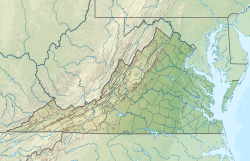| Manassas Sandstone | |
|---|---|
| Stratigraphic range: Carnian | |
| Type | Geological formation |
| Unit of | Chatham Group |
| Lithology | |
| Primary | Sandstone, shale |
| Location | |
| Coordinates | 38°54′N77°42′W / 38.9°N 77.7°W |
| Approximate paleocoordinates | 13°12′N22°00′W / 13.2°N 22.0°W |
| Region | Virginia |
| Country | United States |
The Manassas Sandstone is a Carnian Stage sandstone geological formation in Virginia, United States.
Contents
The Carnian Stage is part of the Triassic System of the Mesozoic.
Fossil theropod tracks have been reported from the formation. [1]

